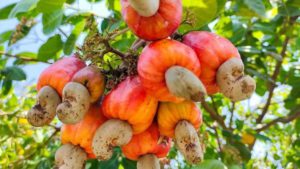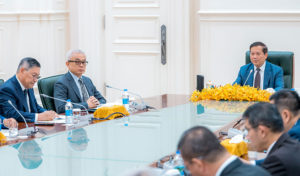Minister of Agriculture, Forestry and Fisheries Dith Tina on Monday asked the Cambodian Cassava Federation (CFC) to be flexible and prepare a clear strategic plan to maintain market stability, prevent price declines, and prioritize the trade of fresh cassava and the processing of dried cassava for export.
Tina made the remarks during a meeting to discuss the federation’s work and progress with Chray Son, president of the Cambodian Cassava Federation, and colleagues at the ministry’s office.
“The federation must be flexible, aware of demand and supply, and have a clear strategic plan, and should plant at a level that maintains market stability without encouraging expansion of production areas to avoid price declines,” the minister said.
The minister also instructed the federation to carefully evaluate its organizational structure and key roles in cassava trading and processing by pooling resources, collaborating effectively, gaining a clear understanding of market size, considering economic efficiency, maintaining a strong position, and working towards its market goals.
Tina said the ministry has been promoting the development of modern farming communities that bring together farmers to cultivate together. These communities are designed with clear production plans, supply that meets market needs, adherence to proper technical standards, and real market access.
“The Cambodian Cassava Federation should prioritize the trade of fresh cassava and the processing of dried cassava for export rather than competing with farmers in cultivation,” the Minister said.
He encouraged the Federation to continue to collaborate with the Ministry of Agriculture and stakeholders to address challenges and achieve success that benefits farmers.
Recently, Mr. Chray Son emphasized the great potential of the subsector, noting that currently 95 percent of fresh cassava is exported, with 5 percent processed locally, contributing an estimated $728 million to the economy.
“Cambodia ranks as the fourth largest cassava exporter in Asia and the 10th largest cassava exporter in the world, with a cultivated area of 60,000 to 80,000 hectares. Cassava can be processed into a variety of products, including flour, bread, cakes, potato chips, beverages, and industrial goods such as paper,” said Mr. Chray Son.
He added that the Cambodian Cassava Federation will collaborate with development partners and organizations to expand and strengthen cultivation techniques and enhance production capacity to national and international standards for the farming community, especially the General Department of Agriculture of the Ministry of Agriculture, Forestry and Fisheries.
Regarding cassava prices, Mr. L. Chhin, president of the Cambodian Cassava Farmers Association, told the Khmer Times that cassava prices vary by region, but in Cambodia, cassava prices are still low.
The lowest prices are in Preah Vihear, Oddar Meanchey and Banteay Meanchey provinces, where prices range between 190 and 220 riel per kilogram. In Pailin province, prices are above 250 riel, while in Mondulkiri and Kampong Cham provinces, prices are above 300 riel.
Mr. L. Chhin added that about 20 to 30 percent of domestic cassava production is consumed domestically, with the rest exported mainly to Thailand and Vietnam.
Cambodia produces more than 10 million tons of cassava per year, with only about 2 to 3 million tons per year.
There are about 12 cassava processing factories across the country, but currently only about 4 to 5 factories are operating.
It is worth recalling that the Royal Government has established a National Cassava Policy for 2020-2025, which aims to make Cambodia a reliable producer, processor, and supplier of cassava products to boost exports to the world market.







